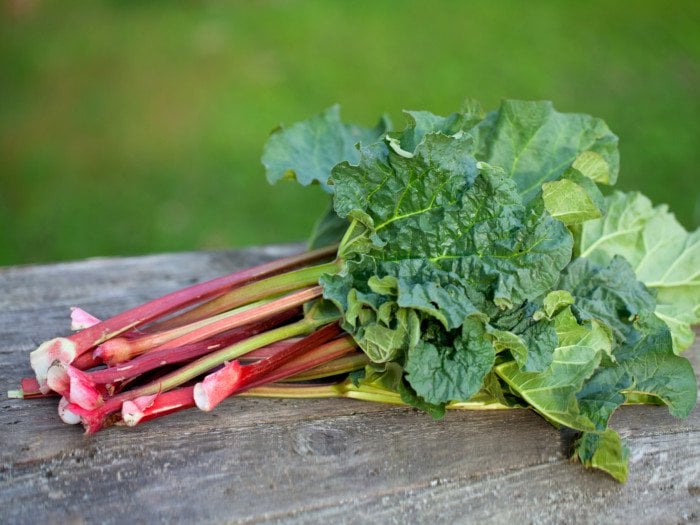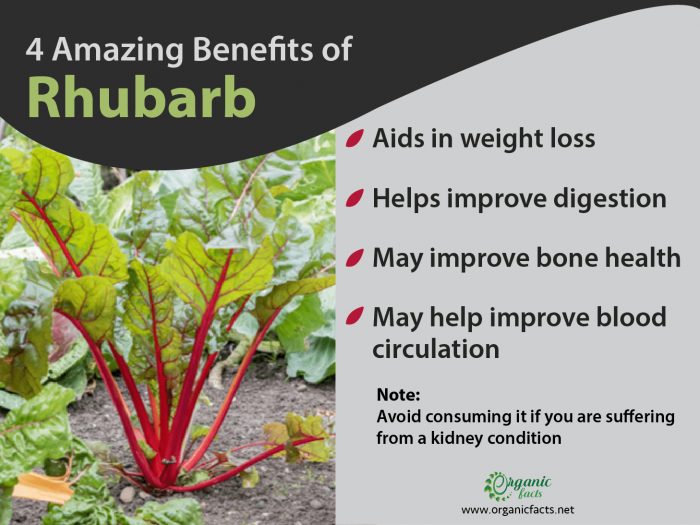The health benefits of rhubarb may include its potential ability to promote weight loss, improve digestion, stimulate bone growth, avoid neuronal damage, boost skin health, enhance metabolism, improve circulation, and protect against cardiovascular conditions.
What is Rhubarb?
Rhubarb, a part of the Polygonaceae family of plants, is a unique looking plant with a very interesting history. Scientifically, it is an herbaceous perennial with leaves growing off the top of a thick rhizome. [1]
Although widely considered as a vegetable, in America, it is treated as a fruit, in culinary practices. The leaf stalks are actually the only parts of the plant consumed, sometimes as a dessert or an ingredient in sweet dishes.
It is cultivated throughout the year in different parts of the world and is widely available in any season. It possibly grows in greenhouses, resulting in “hothouse” rhubarb, which is sweeter and deeper red in color, while the traditional variety is grown outside. One of the main reasons why people cultivate and eat rhubarb is its astounding nutritional value. It is packed with minerals, vitamins. organic compounds, and other nutrients that make it ideal for keeping our bodies healthy.

Rhubarb is a perennial plant that has stalks similar to celery. Photo Credit: Shutterstock
What does Rhubarb Taste like?
The taste of rhubarb is somewhat similar to that of green apples, which is to say that it is tart. Usually, people add sugar to make it sweeter and then bake or cook it. Also, raw rhubarbs have a sour and acidic taste.
It is also often paired with strawberries because of the lovely pair of tart and sweet that they make. Some people also often compare the taste of it with celery.
Is Rhubarb Poisonous?
Interestingly enough, the stalks are the only things eaten from this plant. The triangular leaves are extremely high in oxalic acid, which can cause severe illnesses in people if consumed, resulting in the common belief that rhubarb is poisonous. If the plant is subject to extreme cold, the dangerous acid can migrate into the stalk, so be sure to store it in a warm or temperate space, just like the climate where it normally grows. [2]
| Serving Size : | |
|---|---|
| Nutrient | Value |
| Water [g] | 93.61 |
| Energy | 21 |
| Energy [kJ] | 88 |
| Protein [g] | 0.9 |
| Total lipid (fat) [g] | 0.2 |
| Ash [g] | 0.76 |
| Carbohydrate, by difference [g] | 4.54 |
| Fiber, total dietary [g] | 1.8 |
| Sugars, total including NLEA [g] | 1.1 |
| Calcium, Ca [mg] | 86 |
| Iron, Fe [mg] | 0.22 |
| Magnesium, Mg [mg] | 12 |
| Phosphorus, P [mg] | 14 |
| Potassium, K [mg] | 288 |
| Sodium, Na [mg] | 4 |
| Zinc, Zn [mg] | 0.1 |
| Copper, Cu [mg] | 0.02 |
| Manganese, Mn [mg] | 0.2 |
| Selenium, Se [µg] | 1.1 |
| Vitamin C, total ascorbic acid [mg] | 8 |
| Thiamin [mg] | 0.02 |
| Riboflavin [mg] | 0.03 |
| Niacin [mg] | 0.3 |
| Pantothenic acid [mg] | 0.09 |
| Vitamin B-6 [mg] | 0.02 |
| Folate, total [µg] | 7 |
| Folate, food [µg] | 7 |
| Folate, DFE [µg] | 7 |
| Choline, total [mg] | 6.1 |
| Vitamin A, RAE [µg] | 5 |
| Carotene, beta [µg] | 61 |
| Vitamin A, IU [IU] | 102 |
| Lutein + zeaxanthin [µg] | 170 |
| Vitamin E (alpha-tocopherol) [mg] | 0.27 |
| Vitamin K (phylloquinone) [µg] | 29.3 |
| Fatty acids, total saturated [g] | 0.05 |
| 14:0 [g] | 0 |
| 16:0 [g] | 0.05 |
| 18:0 [g] | 0 |
| Fatty acids, total monounsaturated [g] | 0.04 |
| 16:1 [g] | 0 |
| 18:1 [g] | 0.04 |
| Fatty acids, total polyunsaturated [g] | 0.1 |
| 18:2 [g] | 0.1 |
| Sources include : USDA [3] | |
Rhubarb Nutrition
According to the USDA, rhubarb provides dietary fiber, protein, vitamin C, vitamin K, B complex vitamins, calcium, potassium, and magnesium. In terms of organic compounds, the plant also contains beta-carotene (which can be enzymatically converted to vitamin A), polyphenols (which can act as antioxidants), lutein, and zeaxanthin. [4] [5]
Health Benefits of Rhubarb
Let’s see how the nutrients add up to the long list of health benefits that rhubarb imparts! [6]
May Aid in Weight Loss
Rhubarb is one of the vegetables with low calories and it is often recommended for people who are struggling to lose weight but still want to remain healthy. 100 grams of the plant contains 21 calories, so feel free to load up on it without packing on any pounds. Additionally, the fiber helps you feel full faster which may further reduce total caloric intake and promote weight loss. A study published in the Journal of Zhejiang University of Traditional Chinese Medicine showed that compounds in rhubarb may help gastric emptying which may promote weight loss. [7] [8]
May Help Keep Your Heart Healthy
The fiber present in rhubarb stalks can be helpful in lowering cholesterol levels. In an animal study published in the Nutrition Research journal, it was found that rhubarb can help in regulating cholesterol levels even if you eat a moderately cholesterol-enriched diet. [9]
May Aid in Digestion
The possibly high amount of dietary fiber found in rhubarb may guarantee a healthy digestive system by bulking up the stool, making sure that bowel movements are smooth and regular. Also, it has traditionally been used as a cure for constipation but was only recently discovered why. By easing constipation and other digestive issues, rhubarb may help prevent a wide range of more serious gastrointestinal disorders, which include bloating and cramping. [10]
May Have Anti-Alzheimer’s Effects
According to a study published in the Brain Research Bulletin journal, rhubarb glucoside compound rhaponticin protects the body against Alzheimer’s. Furthermore, in vitro results show the positive effect of rhaponticin in preventing the harmful effects of amyloid-beta that are crucial in the formation of senile plaques. Based on this study, it is suggested that rhaponticin could possibly be developed as an agent for the management of Alzheimer’s disease. [11] [12]
May Improve Bone Health
Rhubarb is a good source of vitamin K that is associated with promoting osteotropic activity, meaning that it stimulates bone growth and repair. Combined with the potentially rich amount of calcium and other minerals found in rhubarb, the vegetable as a whole is a major player in bone protection. [13]
May Improve Blood Circulation
The trace amounts of copper and iron found in rhubarb are essential for the production of new red blood cells, necessary to maintain the total RBC count in the body. Maintaining adequate healthy red blood cells is essential for oxygenation of the body, thereby ensuring optimum function. Furthermore, according to an animal study in the Chinese Medicine Journal, rhubarb not only promotes blood circulation but also processes the effect of hemostasis. [14] [15]

One of the main reasons why people cultivate and eat rhubarb is for its astounding nutritional value.
May Help Manage Diabetes
Rhubarb is low in carbohydrates and can be used in preparations that are diabetes-friendly. A 2018 study suggests the use of the essential oil extract of the rhubarb stem as an additional treatment, owing to its positive effect on fasting blood glucose levels. Another paper published in the Systems Microbiology journal suggests that rhubarb extracts can exert a hypoglycemic effect as well as improve gut microbiota. [16] [17] [18]
Other Benefits
Might Improve Vision
Rhubarb may contain beta-carotene, vitamin C and lutein, which are compounds that are beneficial for vision and protective to the retina. [19]
May Relieve Perimenopause Symptoms
This amazing plant can also help with perimenopause symptoms by reducing the occurrences of hot flashes, due to the presence of phytoestrogens. [20] [21]
May Improve Skin Care
Rhubarb being rich in vitamin A, a potential antioxidant, may help fight off free radicals and delay the signs of aging including wrinkles and fine lines. It also acts as an anti-inflammatory and antibacterial agent that may help prevent skin infections and acne. [22]
How to Store Rhubarb?
Before you store your rhubarb, you need to make sure its stalks are crisp and have a reddish tinge to them. Make sure the leaves are attached (not drooping) to ensure that it is still fresh. Once you’ve bought rhubarb, store it as follows.
Fresh
- Step 1: Cut off the leaves.
- Step 2: Cut off the imperfections.
- Step 3: Wash and dry the plant.
- Step 4: Wrap it in a paper towel or foil and refrigerate it!
How to Freeze Rhubarb?
- Step 1: Chop off the leaves.
- Step 2: Get rid of all the imperfections in the plant.
- Step 3: Wash it properly and then dry the plant.
- Step 4: Chop rhubarb into small and even pieces.
- Step 5: Put it in a freezer bag and empty it of all the air.
- Step 6: Put it in the freezer and use it throughout the year.
Note: Make sure to thaw and drain the frozen rhubarb before using it.
Rhubarb Uses
Rhubarb first appeared in the United Kingdom approximately 400 years ago and has since become highly prized for its unique flavor and sweet taste around the world. It is used in various dishes and recipes including the following:
- Strawberry rhubarb pie
- Cakes
- Juices
- Rhubarb sauce
- Jams
- Fruit wine or Sima
- Compote
Rhubarb is also used for medicinal purposes in traditional Chinese and medieval Arabian and European medicine. Rhubarb has been suggested to exert eliminating heat, purging fire, treat constipation, cooling blood, treat gastrointestinal bleeding, and other diseases. The roots of this plant have been used as a laxative for thousands of years. [23]
Word of Caution: Avoid use if suffering from a pre-existing kidney condition or certain gastrointestinal conditions (as it is high in potassium), as rhubarb can make them worse. Also, be careful that children or pets do not eat rhubarb leaves. There have been some cases of death due to the toxic levels of oxalic acid contained in the leaves. Rhubarb stalks, however, are healthy and delicious, so enjoy! [24]
